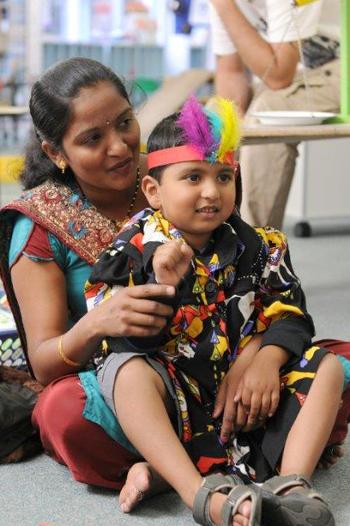Telling stories
Duration/age

There are many different ways that we share stories. It can be by talking, reading a book, showing a painting, drawing, weaving or design or by using the natural environment. One way to share stories with your child is to tell them - using memory or imagination.
As you snuggle up close with your child and tell stories they will notice how your voice, face and body changes as the story develops. As the tale changes and grows - and each new character is introduced - they will hear different words and language.
From the words that are spoken they will begin to form pictures in their mind. Is the character an old man with wrinkled skin who looks like a dry creek bed? Is it a tale about a new baby that smells of cottonwool balls and talcum powder? The way you describe the characters and events will help your child to create mental pictures of what is happening.
We rolled down a hill that was so lumpy it felt like a carpet that had been unrolled after being curled up for years and years.
The bowl of fruit gave the kitchen the smell of summer stone fruit ripening under the hot summer sun.
Materials you will need
- Your voice
Alternative tools
- Pictures
- Stones
- Fabric
- Family photos
- Family treasures
- Objects
Skills this activity improves
Why does this matter?
Taking part in storytelling helps your child to develop their listening skills, observational skills and imagination. As they listen to you they will hear and see how your face, voice and body changes to reflect the different characters in the story. As they listen to the story, the description of the characters and where the events take place they are developing oral language and the ability to take the language and turn it into pictures.
Telling stories helps your child to hear how a story is organised with a beginning, a middle and an end.
Storytelling helps you to share stories and traditions from your family with your child. As you tell the story you will be explaining who told you the story and why it is important to your family and culture.
What does this lead to?
As your child grows older, understanding the different ways language can be presented will help them to make decisions on how to organise or record their thinking. Telling stories helps them to develop rich oral language that allows the listener to see what you see through the description of the event.
Telling stories helps your child to develop good listening skills and to ask questions. As there are no pictures to give clues to what is happening in the story, if your child stops listening or is distracted they will not be able to follow the story and know what is going on.
Sharing traditional and important stories from your own culture and family helps your child to develop a strong cultural identity. The sharing of family and cultural stories helps to keep the stories alive and to pass on important information about the family, behaviours and traditions that are often not written down.
Language to use
- Beginning, middle, end
- Characters, people, players
- Event
- Told story, read story, storybook, print story, picture book
- Once upon a time, a long-long time ago, when I was very little
- Did you ever hear about . . . ?
- I have a story to share with you about . . .
- When I was little my Dad / Mum / Grandmother / Grandfather told me a story about . . .
Questions to use
- What do you think this story might be about?
- Who do you think might be in the story?
- What do you think will happen to the characters in the story?
- How could we change the ending?
- Do you remember what happens in the story?
Useful tips
- You might also like to take a look at the Storytelling stones activity.
- If your child is a little younger use a picture to help tell the story. This will help them to focus and listen.
- You can make up stories about well-known people and events to help your child predict what is coming up in the story.
- Children often love to hear favourite stories told over and over again. Sometimes change the ending to see if they notice.
- Remember to talk to your child in your home language.
More ideas
- Record your stories using your own voice or with other family members telling the tales.
- Make props to go with the stories. Your child can find a prop that matches the part of the story you are telling.
Variation by age
Birth to two year olds
- Make a ‘feely’ bag with different things from the story. Ask your child to feel for the different objects as you read the story.
- Make a bingo game with some of the characters from the story.
Three to five year olds
- Make a ‘feely’ bag with different things from the story. Ask your child to feel for the different objects as you read the story.
- Make a bingo game with some of the characters from the story.
- Make pop-stick puppets of the characters in the story. Your child could help to tell the story using the puppets.
- Create a sand tray with assorted things from nature for telling stories.
- Video your child telling stories.


